
Gantt charts are becoming an increasingly popular use for Google Sheets as a way to easily share data among team members and keep projects on track.
Included on this page, you’ll find detailed instructions on how to create a Gantt chart in Google Sheets and tips for setting up dependent tasks. Plus, learn how to export your Gantt chart to Microsoft Excel. You can also skip the steps and download a free, customizable Gantt chart template in Google Sheets.
Follow the steps below to quickly create a Gantt chart using Google Sheets. A Gantt chart in Google Sheets can help you track your project progress and keep an eye on key milestones.
To learn more about Gantt charts, including their history and why they’re a beneficial tool for project management, visit this article about Gantt charts. For even more ways to create a Gantt chart in different forms, including Microsoft Excel, Apple Pages, Apple Numbers, and Google Sheets, visit our comprehensive how-to article.


You’ll need to make two tables. The first table will serve as a template for the calculations you create in the second table.
Then label the cells as follows:



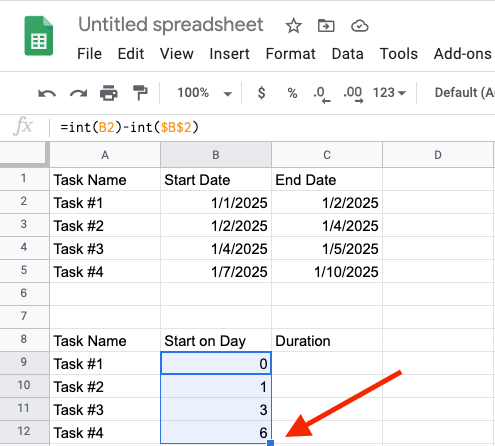
Pro Tip: The cell numbers might differ (e.g., C4 might be C10) depending on where you place project data in the sheet, but every other part of the formula should remain the same.





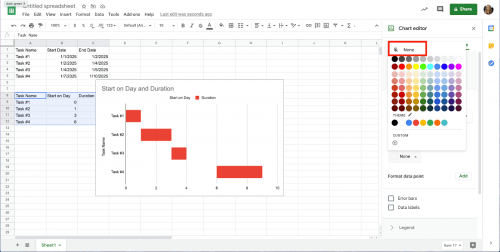
It’s easy to customize everything from the title to the style of the bars on a Gantt chart. Follow the steps below to create 3D bars, remove the legend, change font colors, and more.

Follow these steps to change the appearance of your chart by adjusting the border color or making the bars pop in 3D.
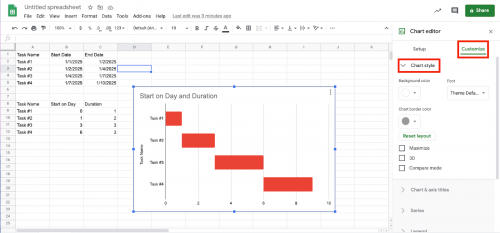





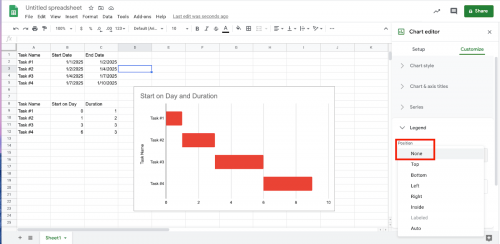
More complex projects will likely have project tasks that are dependent on one another — meaning, you can’t start some tasks until a previous task or series of tasks is complete. Follow these steps to ensure a dependent task does not start before the previous one is complete.
Pro Tip: The values in this formula should be the tasks that must be completed before a dependent task can start. The +1 signifies this task can only start the day after the other tasks in the formula are completed.

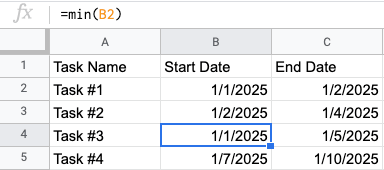
With some projects, tasks need to happen simultaneously based on a predetermined timeline. Follow these steps to set up a system for tracking dependent tasks that happen concurrently with previous tasks.
Pro Tip: The values in this formula should be the tasks that you want to start at the same time as the dependent task. In this example, the task in cells B2 and B4 should be scheduled at the same time as the dependent task.

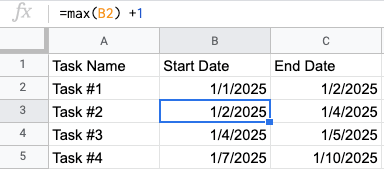
Some people prefer working in a more familiar spreadsheet interface, such as Microsoft Excel. Follow these steps to export a Gantt chart and all corresponding project data in Google Sheets to Excel.
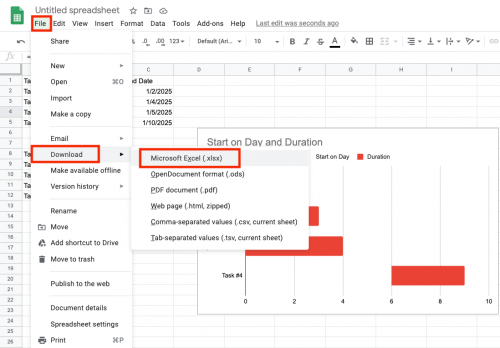

Track project progress, create dependent tasks, and visualize how each task is moving forward with this simple Gantt chart template in Google Sheets.
Download Gantt Chart Template - Google Sheets
Watch this short video to see how you can quickly turn a spreadsheet into a Gantt chart in a few easy steps using Smartsheet.
 Dynamic Gantt Chart Template with Critical Path Google Sheets" width="1226" height="1225" />
Dynamic Gantt Chart Template with Critical Path Google Sheets" width="1226" height="1225" />
With this intricate Gantt chart template, you can not only track each project task as it moves along and plot dependencies on your chart, but you can also identify your project’s critical path. That way, you won’t miss key tasks in the process.
Peruse our collection of Gantt chart templates to find downloadable versions in other formats.
Empower your people to go above and beyond with a flexible platform designed to match the needs of your team — and adapt as those needs change.
The Smartsheet platform makes it easy to plan, capture, manage, and report on work from anywhere, helping your team be more effective and get more done. Report on key metrics and get real-time visibility into work as it happens with roll-up reports, dashboards, and automated workflows built to keep your team connected and informed.
When teams have clarity into the work getting done, there’s no telling how much more they can accomplish in the same amount of time. Try Smartsheet for free, today.